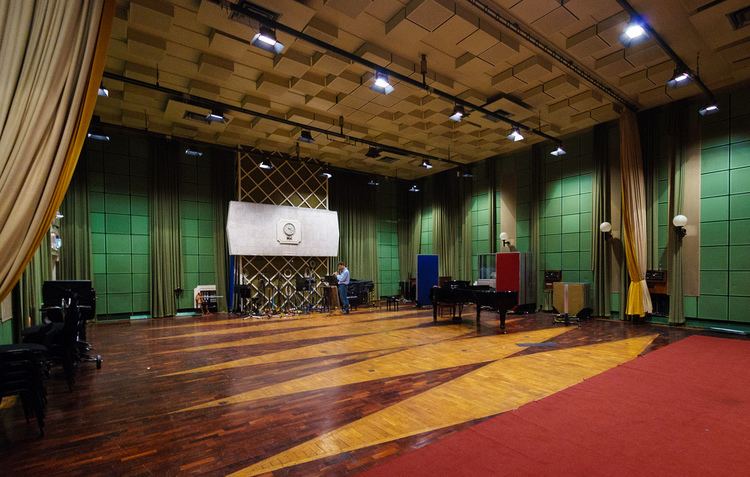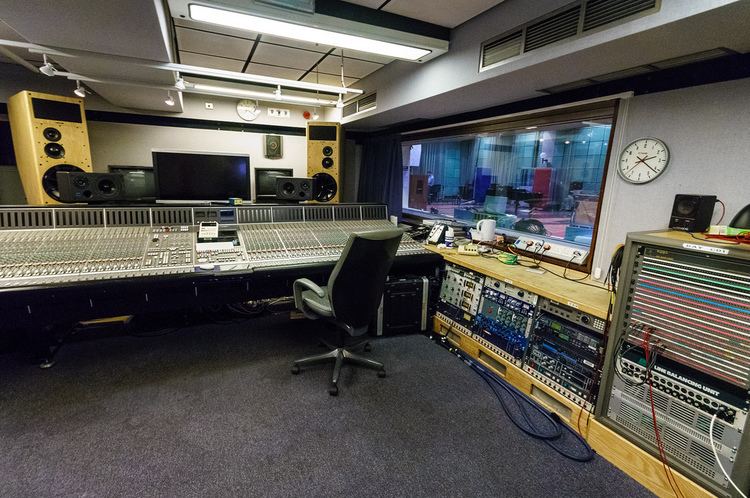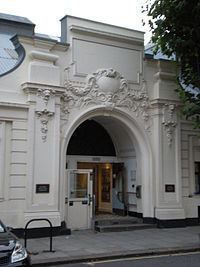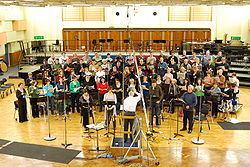London borough City of Westminster | ||
 | ||
Setting up a session recording at maida vale studios
Maida Vale Studios is a complex of seven BBC sound studios, of which five are in regular use, in Delaware Road, Maida Vale, London.
Contents
- Setting up a session recording at maida vale studios
- Blondie live at the bbc maida vale studios
- Early years
- Current use
- John Peel Sessions
- Memories
- References

It has been used to record thousands of classical music, popular music and drama sessions for BBC Radio 1, BBC Radio 2, BBC Radio 3, BBC Radio 4 and BBC Radio 6 Music from 1946 to the present. On 30 October 2009, BBC Radio 1 celebrated 75 Years of Maida Vale by exclusively playing 75 tracks recorded at the studios over the years. Snow Patrol played a live set from the studio with Fearne Cotton to celebrate 75 years of live music.

Blondie live at the bbc maida vale studios
Early years

The site was built in 1909 as the Maida Vale Roller Skating Palace and Club. Over a period of 15 months in 1933/1934, one hundred men reduced the skating rink to a shell, then rebuilt it. The arches at the doorway were preserved. It was one of the BBC's earliest premises, pre-dating Broadcasting House, and was the centre of the BBC News operation during World War II.

It has been the home of the BBC Symphony Orchestra since 1934, where they have given invitation concerts, usually free. As a schoolboy, conductor Vernon Handley learned some of his technique by watching Sir Adrian Boult conduct the BBC symphony orchestra here. Studio MV1 has room for an orchestra of over 150 musicians and an audience of over 200. An unusual feature of these concerts is that they were often recorded, which means that in later years the orchestra sometimes were able to do re-takes. It is the largest classical music studio in London.

The BBC Third Programme (now Radio 3) was created in September 1946. By the 1950s, it was frequently broadcasting concerts from this venue, including the first broadcast performance of Carl Orff's Carmina Burana given by the resident orchestra with the Goldsmiths Choral Union and soloists. Some premieres of British classical music were recorded in studio MV1, including works by Robert Simpson, Arnold Bax, Nicholas Maw, Alan Rawsthorne and Sir Arthur Bliss. Many of them later became available on vinyl or CD. Olivier Messiaen's Turangalila was rehearsed here, before its UK premiere at the Royal Festival Hall.

In 1958 the BBC Radiophonic Workshop was created and based here until its demise in 1998, and the pioneering Delaware synthesiser made by EMS takes its name from the studios' address. The workshop's rooms are now used as a small TV studio for the Film programme, audio archiving facilities, engineering workshops and office space.
In the late 1950s and early 1960s the radio programme Movie-Go-Round was broadcast from here. Peter Haigh played sound clips from major films.
The Beatles used studio MV5 several times in 1963 to record sessions for BBC radio.
The famous sessions for John Peel's Radio 1 programme were recorded at Maida Vale.
Current use
The studios have been under regular threat of closure by BBC management: the building is in need of constant maintenance and due to its location in a residential area there are limits to the hours of operation and access. In July 2007 the BBC announced that the studios were "wholly unsuitable for the 21st century", and it was reported that it would be sold to property developers as part of cost-cutting measures. However, no viable alternatives have been found to house Maida Vale's various activities, and therefore the studios are still in constant use.
John Peel Sessions
From 1967 to 2004, the John Peel Sessions were recorded in studio MV4. At first a number of other venues around London were also used, such as the Playhouse Theatre in Charing Cross, but as these were let go by the BBC the sessions increasingly centred on Maida Vale 4. Music sessions were once a mainstay of BBC Radio programming as there were strict limits on the amount of commercially recorded music that could be aired, known as needle-time restrictions, so the BBC regularly booked musicians to record music exclusively for broadcast. In the early 1960s when the BBC began to give some limited coverage of pop groups such as The Beatles, it was found that the sessions allowed up-and-coming bands to gain exposure, and for musicians and groups to try out new material, play covers they would not include on their albums, and experiment with different sounds and guest musicians. With the birth of Radio 1 in 1967, programmes such as Top Gear embraced this concept, with sessions from such stars-in-waiting as David Bowie, Led Zeppelin and Jimi Hendrix. And when one of Top Gear's presenters, John Peel, got his own programme, he again continued to commission these specially recorded sessions. Most of the artists were relatively unknown even to Peel's listeners: he and his producer would often invite bands on the strength of a rough demo tape or gig to hear what they could do, and for many of the bands it was their first experience of a professional recording studio, not to mention a much-needed boost to their finances. The format became standardised as a single session in the studio with a staff producer and engineer (or more latterly a producer-engineer and assistant), during which the artists would record four songs, but there were also some sessions which were either live to air, or pre-recorded as live with an audience. Other Radio 1 programmes and DJs adopted a similar system of Maida Vale sessions, such as Janice Long, Andy Kershaw, and The Evening Session, whose current host Zane Lowe has nicknamed the studio 'Maida Vegas'; as well as the more direct inheritors of the Peel Sessions tradition Huw Stevens, Rob da Bank and Mike Davies.
Peel said "The Clash did half one, then amazingly said that the equipment in the studio wasn't up to the standards they'd expected so they couldn't complete the session. Which seemed to me to be unbearably pretentious of them." Some albums by The Fall were entirely recorded there. The last band to record a Peel session was Skimmer, at Maida Vale Studios on 21 October 2004.
Other BBC disc jockeys invited artists to perform at Maida Vale. Led Zeppelin recorded for Alexis Korner's Rhythm and Blues programme in 1969. Walter Trout recorded for Paul Jones's R & B show. Marillion recorded for Radio 2 DJ Bob Harris. Jo Whiley invited Hard Fi to play here. The venue is also the home of the BBC Elstree concert Band. The Radio 3 Jazz Line Up sessions were recorded here.
In 1994 the Beatles album Live at the BBC was released, with most of the material having been recorded at Maida Vale. Several other albums, sometimes named after the studios, were recorded in studio MV4. Van der Graaf Generator released an album called Maida Vale in 1994. Portions of October 1990 and September 1991 sessions by Nirvana were released in 2004 on the band's With the Lights Out box set. In 2006 the group Hefner released an album called Maida Vale, which was recorded here. The White Stripes included their version of the Dusty Springfield classic I Don't Know What To Do With Myself, recorded for The Evening Session in MV4 by Miti Adhikari on their album Elephant. In 2002 Andrea Bocelli's Sentomento was made here. The label Maida Vale Records, a subsidiary of Cooking Vinyl, has a policy of releasing material from various radio stations.
Memories
Robin Dallaway of The Cravats remarks that recording at Maida Vale was like stepping back into the 1940s: "blokes in brown stockmen's coats scurried around fixing stuff and plugging our gear in." When Broadcast made their Peel sessions, Trish Keenan wrote "There was a sense of initiation on entering the Maida Vale studios. ... we wandered through the corridors, peering through the windows of locked rooms, on a hunt for the Radiophonic Workshop. We came across abandoned tape machines and Shostakovich posters in the hallways... We hovered outside the locked Radiophonic room, a little disappointed by what we could see through the window. We contemplated unscrewing the Radiophonic Workshop name plate from the door and making off with it, but knew the stern-faced security guard from earlier would have been on to us."
